Health Workforce in Australia: Immigration and Policies Review
VerifiedAdded on 2023/01/17
|9
|2247
|72
Report
AI Summary
This report delves into the Australian health workforce, examining its increasing reliance on international health worker immigration. It explores the reasons behind this trend, including workforce shortages due to regulations, an aging population, and the development of new healthcare conditions. The report analyzes current Australian government policies on international health worker immigration, highlighting the restrictions and requirements for overseas-trained doctors. It also discusses the historical factors contributing to this development, such as changes in labor markets and limited medical school opportunities. Furthermore, the report assesses the sustainability of current policies and suggests changes the Australian government should consider to reduce the negative effects of health worker migration, such as diversifying skills and expanding financing mechanisms. The conclusion emphasizes the need for a clear definition of self-sufficiency and sustainability in health workforce policies and the adoption of strategies to increase workforce productivity. The report references various sources, including the Australian Institute of Health and Welfare and the World Health Organization, to support its analysis.
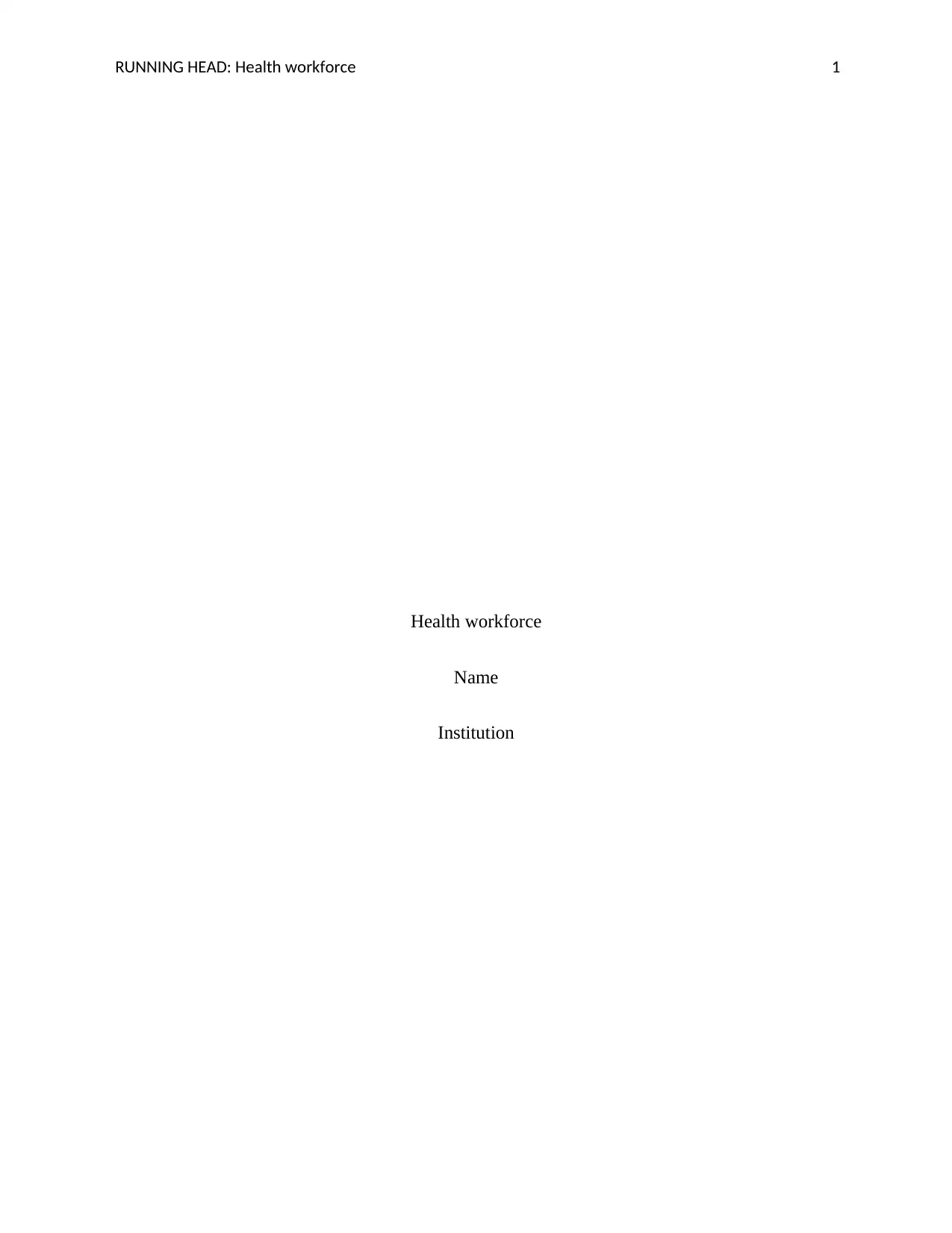
RUNNING HEAD: Health workforce 1
Health workforce
Name
Institution
Health workforce
Name
Institution
Paraphrase This Document
Need a fresh take? Get an instant paraphrase of this document with our AI Paraphraser
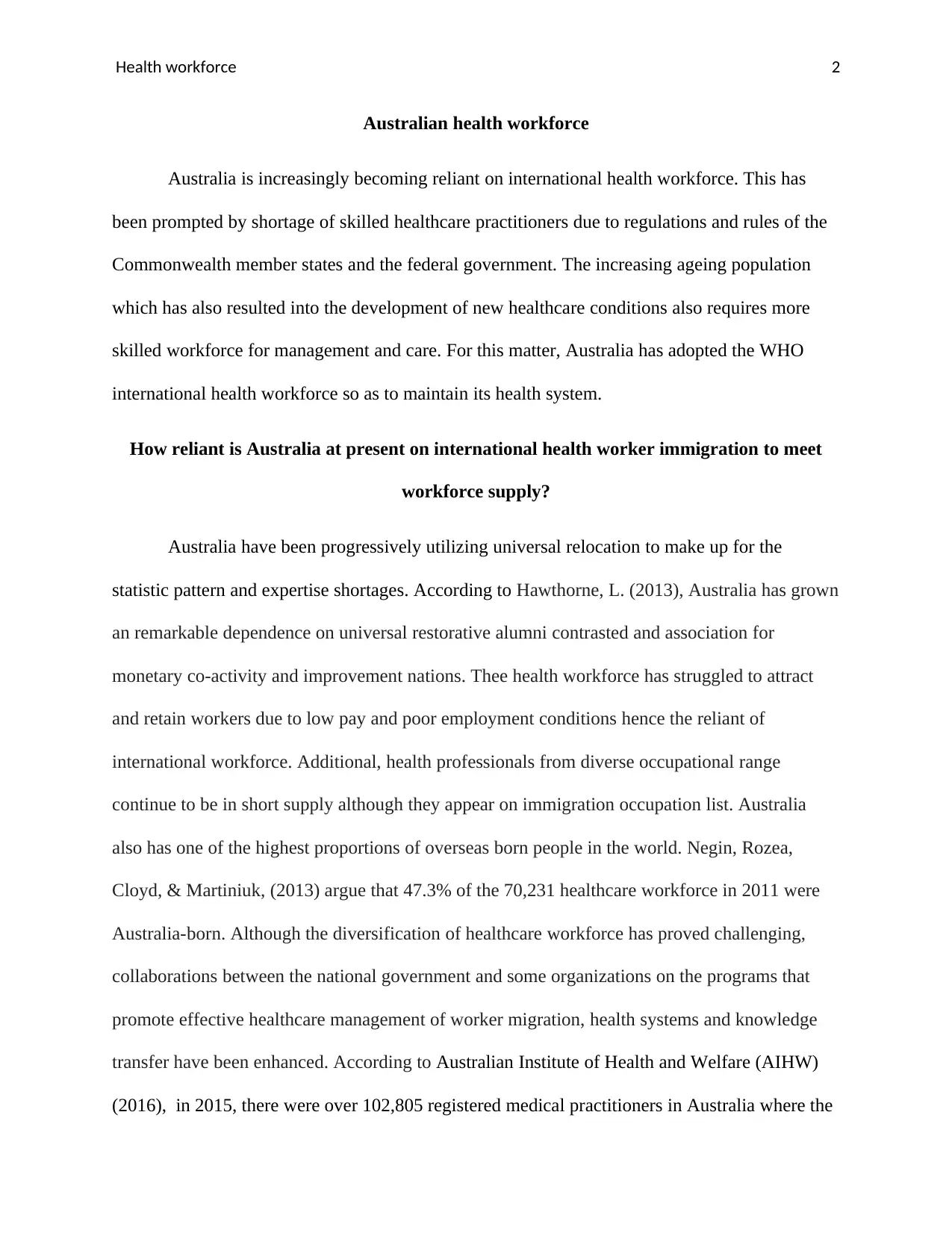
Health workforce 2
Australian health workforce
Australia is increasingly becoming reliant on international health workforce. This has
been prompted by shortage of skilled healthcare practitioners due to regulations and rules of the
Commonwealth member states and the federal government. The increasing ageing population
which has also resulted into the development of new healthcare conditions also requires more
skilled workforce for management and care. For this matter, Australia has adopted the WHO
international health workforce so as to maintain its health system.
How reliant is Australia at present on international health worker immigration to meet
workforce supply?
Australia have been progressively utilizing universal relocation to make up for the
statistic pattern and expertise shortages. According to Hawthorne, L. (2013), Australia has grown
an remarkable dependence on universal restorative alumni contrasted and association for
monetary co-activity and improvement nations. Thee health workforce has struggled to attract
and retain workers due to low pay and poor employment conditions hence the reliant of
international workforce. Additional, health professionals from diverse occupational range
continue to be in short supply although they appear on immigration occupation list. Australia
also has one of the highest proportions of overseas born people in the world. Negin, Rozea,
Cloyd, & Martiniuk, (2013) argue that 47.3% of the 70,231 healthcare workforce in 2011 were
Australia-born. Although the diversification of healthcare workforce has proved challenging,
collaborations between the national government and some organizations on the programs that
promote effective healthcare management of worker migration, health systems and knowledge
transfer have been enhanced. According to Australian Institute of Health and Welfare (AIHW)
(2016), in 2015, there were over 102,805 registered medical practitioners in Australia where the
Australian health workforce
Australia is increasingly becoming reliant on international health workforce. This has
been prompted by shortage of skilled healthcare practitioners due to regulations and rules of the
Commonwealth member states and the federal government. The increasing ageing population
which has also resulted into the development of new healthcare conditions also requires more
skilled workforce for management and care. For this matter, Australia has adopted the WHO
international health workforce so as to maintain its health system.
How reliant is Australia at present on international health worker immigration to meet
workforce supply?
Australia have been progressively utilizing universal relocation to make up for the
statistic pattern and expertise shortages. According to Hawthorne, L. (2013), Australia has grown
an remarkable dependence on universal restorative alumni contrasted and association for
monetary co-activity and improvement nations. Thee health workforce has struggled to attract
and retain workers due to low pay and poor employment conditions hence the reliant of
international workforce. Additional, health professionals from diverse occupational range
continue to be in short supply although they appear on immigration occupation list. Australia
also has one of the highest proportions of overseas born people in the world. Negin, Rozea,
Cloyd, & Martiniuk, (2013) argue that 47.3% of the 70,231 healthcare workforce in 2011 were
Australia-born. Although the diversification of healthcare workforce has proved challenging,
collaborations between the national government and some organizations on the programs that
promote effective healthcare management of worker migration, health systems and knowledge
transfer have been enhanced. According to Australian Institute of Health and Welfare (AIHW)
(2016), in 2015, there were over 102,805 registered medical practitioners in Australia where the
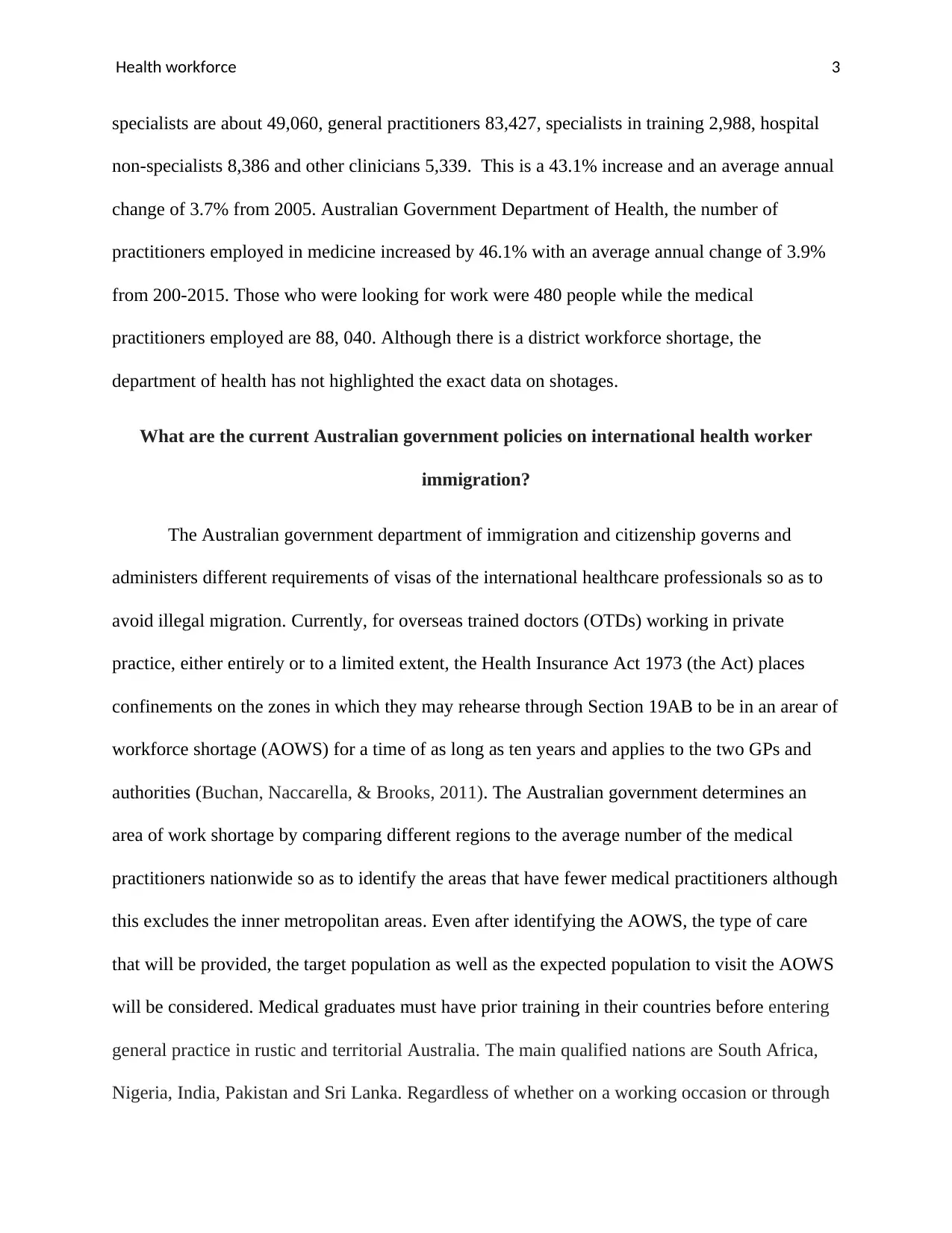
Health workforce 3
specialists are about 49,060, general practitioners 83,427, specialists in training 2,988, hospital
non-specialists 8,386 and other clinicians 5,339. This is a 43.1% increase and an average annual
change of 3.7% from 2005. Australian Government Department of Health, the number of
practitioners employed in medicine increased by 46.1% with an average annual change of 3.9%
from 200-2015. Those who were looking for work were 480 people while the medical
practitioners employed are 88, 040. Although there is a district workforce shortage, the
department of health has not highlighted the exact data on shotages.
What are the current Australian government policies on international health worker
immigration?
The Australian government department of immigration and citizenship governs and
administers different requirements of visas of the international healthcare professionals so as to
avoid illegal migration. Currently, for overseas trained doctors (OTDs) working in private
practice, either entirely or to a limited extent, the Health Insurance Act 1973 (the Act) places
confinements on the zones in which they may rehearse through Section 19AB to be in an arear of
workforce shortage (AOWS) for a time of as long as ten years and applies to the two GPs and
authorities (Buchan, Naccarella, & Brooks, 2011). The Australian government determines an
area of work shortage by comparing different regions to the average number of the medical
practitioners nationwide so as to identify the areas that have fewer medical practitioners although
this excludes the inner metropolitan areas. Even after identifying the AOWS, the type of care
that will be provided, the target population as well as the expected population to visit the AOWS
will be considered. Medical graduates must have prior training in their countries before entering
general practice in rustic and territorial Australia. The main qualified nations are South Africa,
Nigeria, India, Pakistan and Sri Lanka. Regardless of whether on a working occasion or through
specialists are about 49,060, general practitioners 83,427, specialists in training 2,988, hospital
non-specialists 8,386 and other clinicians 5,339. This is a 43.1% increase and an average annual
change of 3.7% from 2005. Australian Government Department of Health, the number of
practitioners employed in medicine increased by 46.1% with an average annual change of 3.9%
from 200-2015. Those who were looking for work were 480 people while the medical
practitioners employed are 88, 040. Although there is a district workforce shortage, the
department of health has not highlighted the exact data on shotages.
What are the current Australian government policies on international health worker
immigration?
The Australian government department of immigration and citizenship governs and
administers different requirements of visas of the international healthcare professionals so as to
avoid illegal migration. Currently, for overseas trained doctors (OTDs) working in private
practice, either entirely or to a limited extent, the Health Insurance Act 1973 (the Act) places
confinements on the zones in which they may rehearse through Section 19AB to be in an arear of
workforce shortage (AOWS) for a time of as long as ten years and applies to the two GPs and
authorities (Buchan, Naccarella, & Brooks, 2011). The Australian government determines an
area of work shortage by comparing different regions to the average number of the medical
practitioners nationwide so as to identify the areas that have fewer medical practitioners although
this excludes the inner metropolitan areas. Even after identifying the AOWS, the type of care
that will be provided, the target population as well as the expected population to visit the AOWS
will be considered. Medical graduates must have prior training in their countries before entering
general practice in rustic and territorial Australia. The main qualified nations are South Africa,
Nigeria, India, Pakistan and Sri Lanka. Regardless of whether on a working occasion or through
⊘ This is a preview!⊘
Do you want full access?
Subscribe today to unlock all pages.

Trusted by 1+ million students worldwide
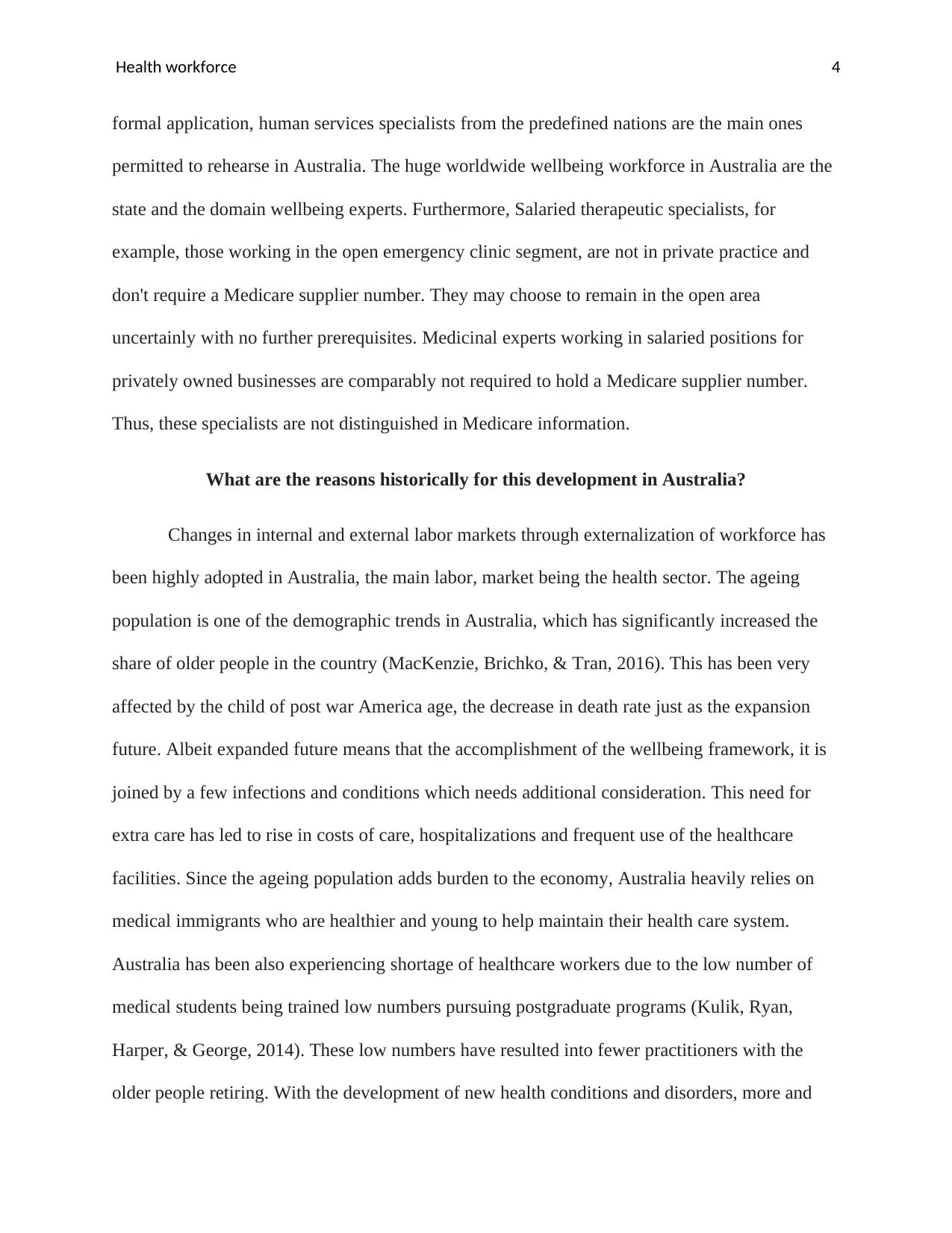
Health workforce 4
formal application, human services specialists from the predefined nations are the main ones
permitted to rehearse in Australia. The huge worldwide wellbeing workforce in Australia are the
state and the domain wellbeing experts. Furthermore, Salaried therapeutic specialists, for
example, those working in the open emergency clinic segment, are not in private practice and
don't require a Medicare supplier number. They may choose to remain in the open area
uncertainly with no further prerequisites. Medicinal experts working in salaried positions for
privately owned businesses are comparably not required to hold a Medicare supplier number.
Thus, these specialists are not distinguished in Medicare information.
What are the reasons historically for this development in Australia?
Changes in internal and external labor markets through externalization of workforce has
been highly adopted in Australia, the main labor, market being the health sector. The ageing
population is one of the demographic trends in Australia, which has significantly increased the
share of older people in the country (MacKenzie, Brichko, & Tran, 2016). This has been very
affected by the child of post war America age, the decrease in death rate just as the expansion
future. Albeit expanded future means that the accomplishment of the wellbeing framework, it is
joined by a few infections and conditions which needs additional consideration. This need for
extra care has led to rise in costs of care, hospitalizations and frequent use of the healthcare
facilities. Since the ageing population adds burden to the economy, Australia heavily relies on
medical immigrants who are healthier and young to help maintain their health care system.
Australia has been also experiencing shortage of healthcare workers due to the low number of
medical students being trained low numbers pursuing postgraduate programs (Kulik, Ryan,
Harper, & George, 2014). These low numbers have resulted into fewer practitioners with the
older people retiring. With the development of new health conditions and disorders, more and
formal application, human services specialists from the predefined nations are the main ones
permitted to rehearse in Australia. The huge worldwide wellbeing workforce in Australia are the
state and the domain wellbeing experts. Furthermore, Salaried therapeutic specialists, for
example, those working in the open emergency clinic segment, are not in private practice and
don't require a Medicare supplier number. They may choose to remain in the open area
uncertainly with no further prerequisites. Medicinal experts working in salaried positions for
privately owned businesses are comparably not required to hold a Medicare supplier number.
Thus, these specialists are not distinguished in Medicare information.
What are the reasons historically for this development in Australia?
Changes in internal and external labor markets through externalization of workforce has
been highly adopted in Australia, the main labor, market being the health sector. The ageing
population is one of the demographic trends in Australia, which has significantly increased the
share of older people in the country (MacKenzie, Brichko, & Tran, 2016). This has been very
affected by the child of post war America age, the decrease in death rate just as the expansion
future. Albeit expanded future means that the accomplishment of the wellbeing framework, it is
joined by a few infections and conditions which needs additional consideration. This need for
extra care has led to rise in costs of care, hospitalizations and frequent use of the healthcare
facilities. Since the ageing population adds burden to the economy, Australia heavily relies on
medical immigrants who are healthier and young to help maintain their health care system.
Australia has been also experiencing shortage of healthcare workers due to the low number of
medical students being trained low numbers pursuing postgraduate programs (Kulik, Ryan,
Harper, & George, 2014). These low numbers have resulted into fewer practitioners with the
older people retiring. With the development of new health conditions and disorders, more and
Paraphrase This Document
Need a fresh take? Get an instant paraphrase of this document with our AI Paraphraser
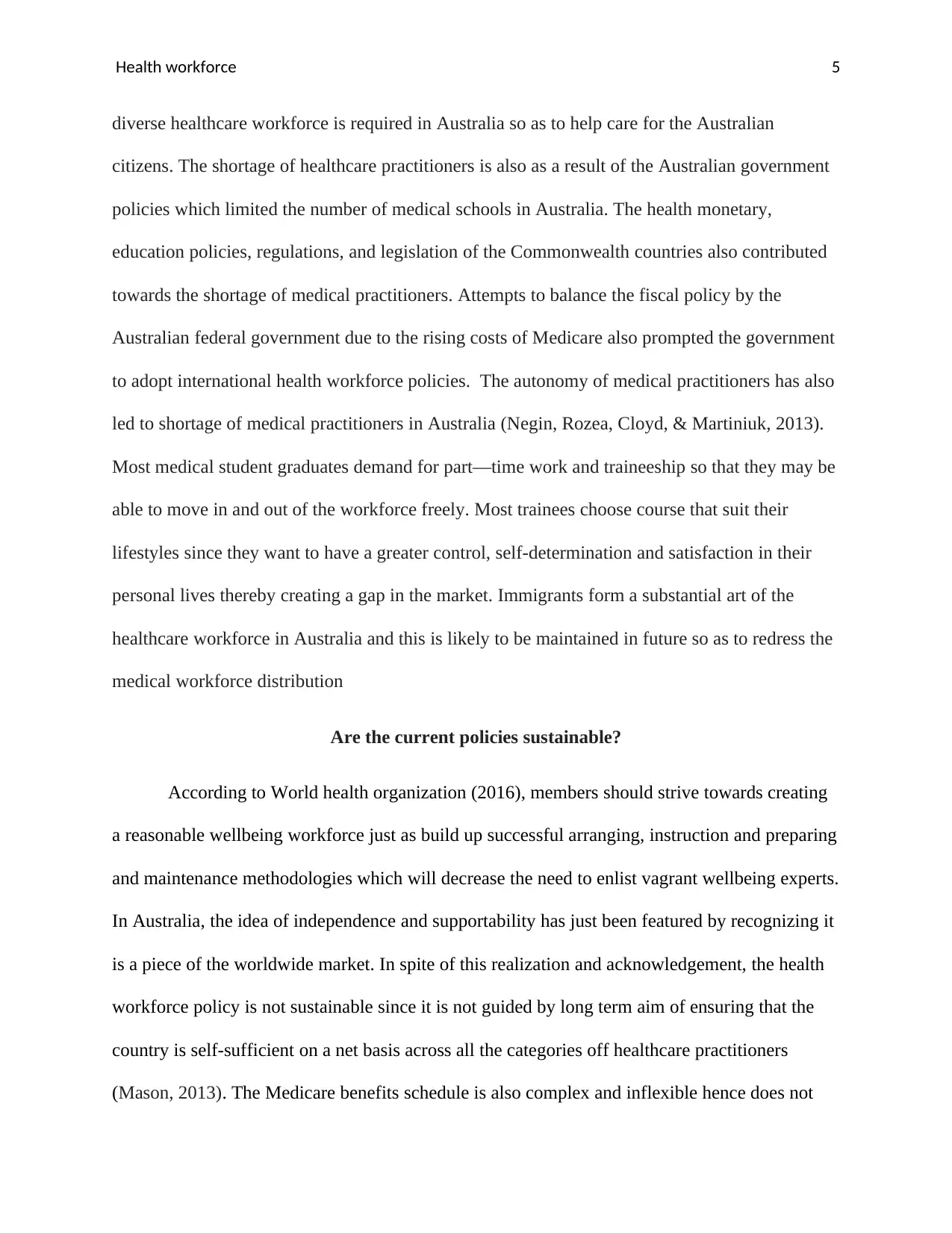
Health workforce 5
diverse healthcare workforce is required in Australia so as to help care for the Australian
citizens. The shortage of healthcare practitioners is also as a result of the Australian government
policies which limited the number of medical schools in Australia. The health monetary,
education policies, regulations, and legislation of the Commonwealth countries also contributed
towards the shortage of medical practitioners. Attempts to balance the fiscal policy by the
Australian federal government due to the rising costs of Medicare also prompted the government
to adopt international health workforce policies. The autonomy of medical practitioners has also
led to shortage of medical practitioners in Australia (Negin, Rozea, Cloyd, & Martiniuk, 2013).
Most medical student graduates demand for part—time work and traineeship so that they may be
able to move in and out of the workforce freely. Most trainees choose course that suit their
lifestyles since they want to have a greater control, self-determination and satisfaction in their
personal lives thereby creating a gap in the market. Immigrants form a substantial art of the
healthcare workforce in Australia and this is likely to be maintained in future so as to redress the
medical workforce distribution
Are the current policies sustainable?
According to World health organization (2016), members should strive towards creating
a reasonable wellbeing workforce just as build up successful arranging, instruction and preparing
and maintenance methodologies which will decrease the need to enlist vagrant wellbeing experts.
In Australia, the idea of independence and supportability has just been featured by recognizing it
is a piece of the worldwide market. In spite of this realization and acknowledgement, the health
workforce policy is not sustainable since it is not guided by long term aim of ensuring that the
country is self-sufficient on a net basis across all the categories off healthcare practitioners
(Mason, 2013). The Medicare benefits schedule is also complex and inflexible hence does not
diverse healthcare workforce is required in Australia so as to help care for the Australian
citizens. The shortage of healthcare practitioners is also as a result of the Australian government
policies which limited the number of medical schools in Australia. The health monetary,
education policies, regulations, and legislation of the Commonwealth countries also contributed
towards the shortage of medical practitioners. Attempts to balance the fiscal policy by the
Australian federal government due to the rising costs of Medicare also prompted the government
to adopt international health workforce policies. The autonomy of medical practitioners has also
led to shortage of medical practitioners in Australia (Negin, Rozea, Cloyd, & Martiniuk, 2013).
Most medical student graduates demand for part—time work and traineeship so that they may be
able to move in and out of the workforce freely. Most trainees choose course that suit their
lifestyles since they want to have a greater control, self-determination and satisfaction in their
personal lives thereby creating a gap in the market. Immigrants form a substantial art of the
healthcare workforce in Australia and this is likely to be maintained in future so as to redress the
medical workforce distribution
Are the current policies sustainable?
According to World health organization (2016), members should strive towards creating
a reasonable wellbeing workforce just as build up successful arranging, instruction and preparing
and maintenance methodologies which will decrease the need to enlist vagrant wellbeing experts.
In Australia, the idea of independence and supportability has just been featured by recognizing it
is a piece of the worldwide market. In spite of this realization and acknowledgement, the health
workforce policy is not sustainable since it is not guided by long term aim of ensuring that the
country is self-sufficient on a net basis across all the categories off healthcare practitioners
(Mason, 2013). The Medicare benefits schedule is also complex and inflexible hence does not
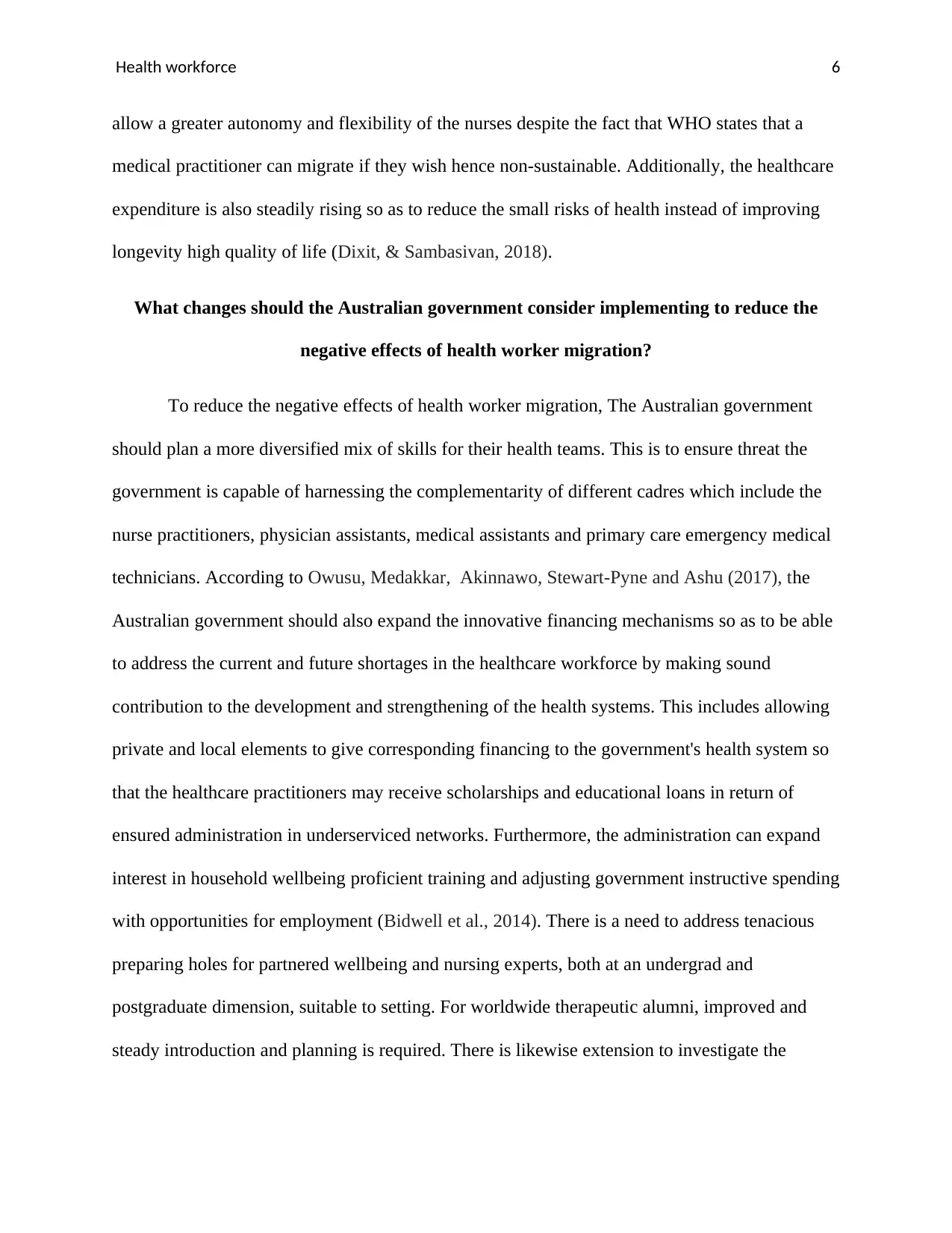
Health workforce 6
allow a greater autonomy and flexibility of the nurses despite the fact that WHO states that a
medical practitioner can migrate if they wish hence non-sustainable. Additionally, the healthcare
expenditure is also steadily rising so as to reduce the small risks of health instead of improving
longevity high quality of life (Dixit, & Sambasivan, 2018).
What changes should the Australian government consider implementing to reduce the
negative effects of health worker migration?
To reduce the negative effects of health worker migration, The Australian government
should plan a more diversified mix of skills for their health teams. This is to ensure threat the
government is capable of harnessing the complementarity of different cadres which include the
nurse practitioners, physician assistants, medical assistants and primary care emergency medical
technicians. According to Owusu, Medakkar, Akinnawo, Stewart-Pyne and Ashu (2017), the
Australian government should also expand the innovative financing mechanisms so as to be able
to address the current and future shortages in the healthcare workforce by making sound
contribution to the development and strengthening of the health systems. This includes allowing
private and local elements to give corresponding financing to the government's health system so
that the healthcare practitioners may receive scholarships and educational loans in return of
ensured administration in underserviced networks. Furthermore, the administration can expand
interest in household wellbeing proficient training and adjusting government instructive spending
with opportunities for employment (Bidwell et al., 2014). There is a need to address tenacious
preparing holes for partnered wellbeing and nursing experts, both at an undergrad and
postgraduate dimension, suitable to setting. For worldwide therapeutic alumni, improved and
steady introduction and planning is required. There is likewise extension to investigate the
allow a greater autonomy and flexibility of the nurses despite the fact that WHO states that a
medical practitioner can migrate if they wish hence non-sustainable. Additionally, the healthcare
expenditure is also steadily rising so as to reduce the small risks of health instead of improving
longevity high quality of life (Dixit, & Sambasivan, 2018).
What changes should the Australian government consider implementing to reduce the
negative effects of health worker migration?
To reduce the negative effects of health worker migration, The Australian government
should plan a more diversified mix of skills for their health teams. This is to ensure threat the
government is capable of harnessing the complementarity of different cadres which include the
nurse practitioners, physician assistants, medical assistants and primary care emergency medical
technicians. According to Owusu, Medakkar, Akinnawo, Stewart-Pyne and Ashu (2017), the
Australian government should also expand the innovative financing mechanisms so as to be able
to address the current and future shortages in the healthcare workforce by making sound
contribution to the development and strengthening of the health systems. This includes allowing
private and local elements to give corresponding financing to the government's health system so
that the healthcare practitioners may receive scholarships and educational loans in return of
ensured administration in underserviced networks. Furthermore, the administration can expand
interest in household wellbeing proficient training and adjusting government instructive spending
with opportunities for employment (Bidwell et al., 2014). There is a need to address tenacious
preparing holes for partnered wellbeing and nursing experts, both at an undergrad and
postgraduate dimension, suitable to setting. For worldwide therapeutic alumni, improved and
steady introduction and planning is required. There is likewise extension to investigate the
⊘ This is a preview!⊘
Do you want full access?
Subscribe today to unlock all pages.

Trusted by 1+ million students worldwide
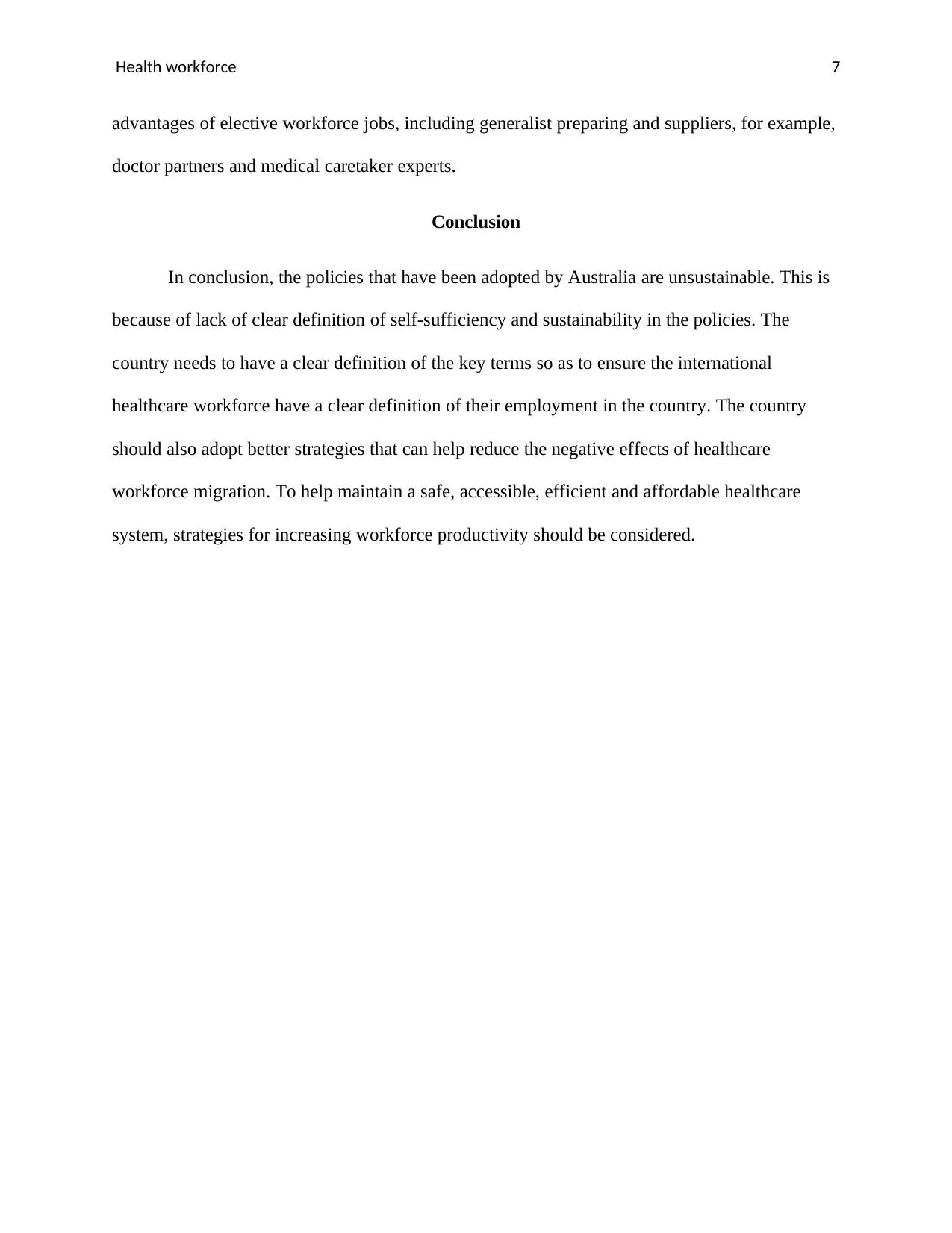
Health workforce 7
advantages of elective workforce jobs, including generalist preparing and suppliers, for example,
doctor partners and medical caretaker experts.
Conclusion
In conclusion, the policies that have been adopted by Australia are unsustainable. This is
because of lack of clear definition of self-sufficiency and sustainability in the policies. The
country needs to have a clear definition of the key terms so as to ensure the international
healthcare workforce have a clear definition of their employment in the country. The country
should also adopt better strategies that can help reduce the negative effects of healthcare
workforce migration. To help maintain a safe, accessible, efficient and affordable healthcare
system, strategies for increasing workforce productivity should be considered.
advantages of elective workforce jobs, including generalist preparing and suppliers, for example,
doctor partners and medical caretaker experts.
Conclusion
In conclusion, the policies that have been adopted by Australia are unsustainable. This is
because of lack of clear definition of self-sufficiency and sustainability in the policies. The
country needs to have a clear definition of the key terms so as to ensure the international
healthcare workforce have a clear definition of their employment in the country. The country
should also adopt better strategies that can help reduce the negative effects of healthcare
workforce migration. To help maintain a safe, accessible, efficient and affordable healthcare
system, strategies for increasing workforce productivity should be considered.
Paraphrase This Document
Need a fresh take? Get an instant paraphrase of this document with our AI Paraphraser
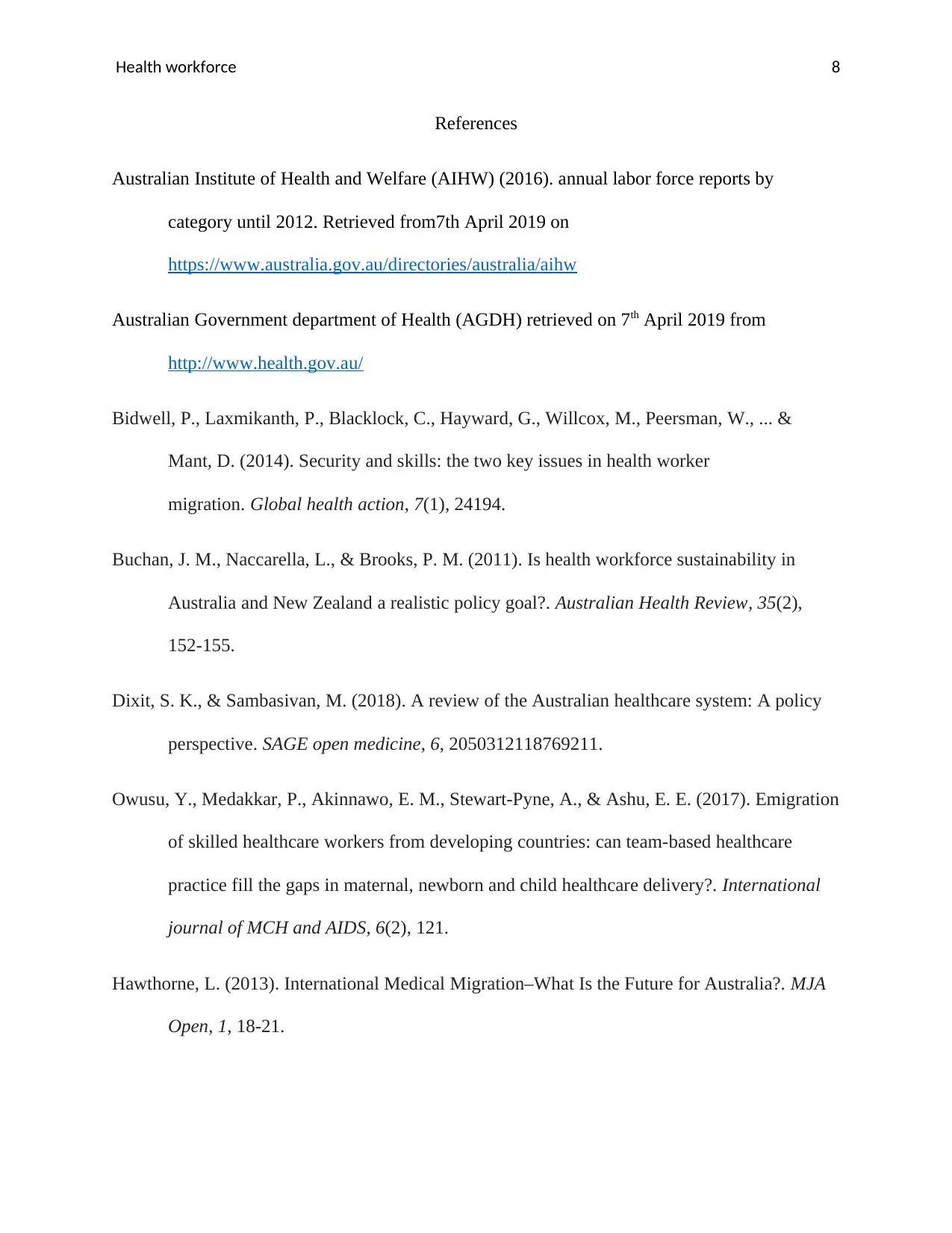
Health workforce 8
References
Australian Institute of Health and Welfare (AIHW) (2016). annual labor force reports by
category until 2012. Retrieved from7th April 2019 on
https://www.australia.gov.au/directories/australia/aihw
Australian Government department of Health (AGDH) retrieved on 7th April 2019 from
http://www.health.gov.au/
Bidwell, P., Laxmikanth, P., Blacklock, C., Hayward, G., Willcox, M., Peersman, W., ... &
Mant, D. (2014). Security and skills: the two key issues in health worker
migration. Global health action, 7(1), 24194.
Buchan, J. M., Naccarella, L., & Brooks, P. M. (2011). Is health workforce sustainability in
Australia and New Zealand a realistic policy goal?. Australian Health Review, 35(2),
152-155.
Dixit, S. K., & Sambasivan, M. (2018). A review of the Australian healthcare system: A policy
perspective. SAGE open medicine, 6, 2050312118769211.
Owusu, Y., Medakkar, P., Akinnawo, E. M., Stewart-Pyne, A., & Ashu, E. E. (2017). Emigration
of skilled healthcare workers from developing countries: can team-based healthcare
practice fill the gaps in maternal, newborn and child healthcare delivery?. International
journal of MCH and AIDS, 6(2), 121.
Hawthorne, L. (2013). International Medical Migration–What Is the Future for Australia?. MJA
Open, 1, 18-21.
References
Australian Institute of Health and Welfare (AIHW) (2016). annual labor force reports by
category until 2012. Retrieved from7th April 2019 on
https://www.australia.gov.au/directories/australia/aihw
Australian Government department of Health (AGDH) retrieved on 7th April 2019 from
http://www.health.gov.au/
Bidwell, P., Laxmikanth, P., Blacklock, C., Hayward, G., Willcox, M., Peersman, W., ... &
Mant, D. (2014). Security and skills: the two key issues in health worker
migration. Global health action, 7(1), 24194.
Buchan, J. M., Naccarella, L., & Brooks, P. M. (2011). Is health workforce sustainability in
Australia and New Zealand a realistic policy goal?. Australian Health Review, 35(2),
152-155.
Dixit, S. K., & Sambasivan, M. (2018). A review of the Australian healthcare system: A policy
perspective. SAGE open medicine, 6, 2050312118769211.
Owusu, Y., Medakkar, P., Akinnawo, E. M., Stewart-Pyne, A., & Ashu, E. E. (2017). Emigration
of skilled healthcare workers from developing countries: can team-based healthcare
practice fill the gaps in maternal, newborn and child healthcare delivery?. International
journal of MCH and AIDS, 6(2), 121.
Hawthorne, L. (2013). International Medical Migration–What Is the Future for Australia?. MJA
Open, 1, 18-21.
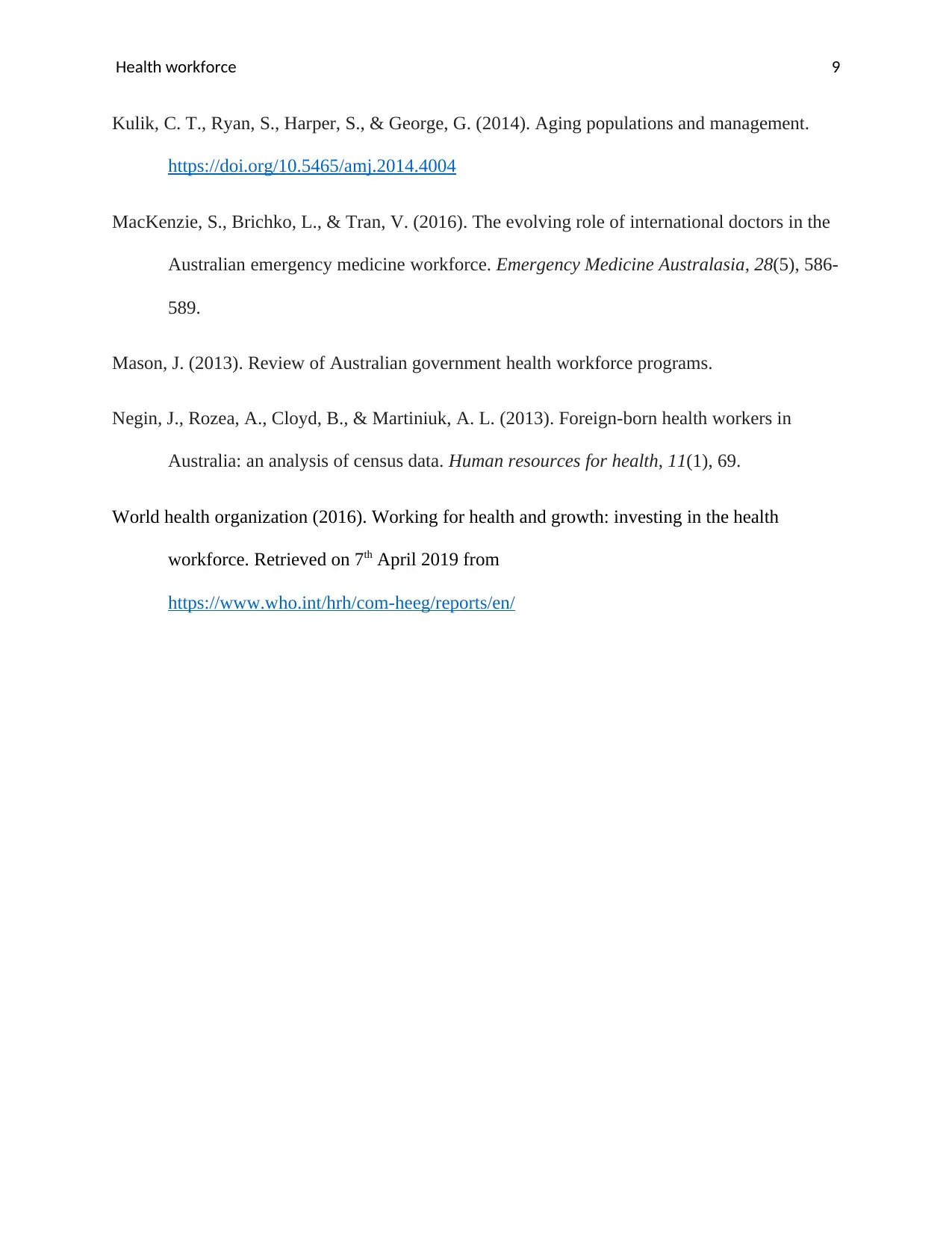
Health workforce 9
Kulik, C. T., Ryan, S., Harper, S., & George, G. (2014). Aging populations and management.
https://doi.org/10.5465/amj.2014.4004
MacKenzie, S., Brichko, L., & Tran, V. (2016). The evolving role of international doctors in the
Australian emergency medicine workforce. Emergency Medicine Australasia, 28(5), 586-
589.
Mason, J. (2013). Review of Australian government health workforce programs.
Negin, J., Rozea, A., Cloyd, B., & Martiniuk, A. L. (2013). Foreign-born health workers in
Australia: an analysis of census data. Human resources for health, 11(1), 69.
World health organization (2016). Working for health and growth: investing in the health
workforce. Retrieved on 7th April 2019 from
https://www.who.int/hrh/com-heeg/reports/en/
Kulik, C. T., Ryan, S., Harper, S., & George, G. (2014). Aging populations and management.
https://doi.org/10.5465/amj.2014.4004
MacKenzie, S., Brichko, L., & Tran, V. (2016). The evolving role of international doctors in the
Australian emergency medicine workforce. Emergency Medicine Australasia, 28(5), 586-
589.
Mason, J. (2013). Review of Australian government health workforce programs.
Negin, J., Rozea, A., Cloyd, B., & Martiniuk, A. L. (2013). Foreign-born health workers in
Australia: an analysis of census data. Human resources for health, 11(1), 69.
World health organization (2016). Working for health and growth: investing in the health
workforce. Retrieved on 7th April 2019 from
https://www.who.int/hrh/com-heeg/reports/en/
⊘ This is a preview!⊘
Do you want full access?
Subscribe today to unlock all pages.

Trusted by 1+ million students worldwide
1 out of 9
Related Documents
Your All-in-One AI-Powered Toolkit for Academic Success.
+13062052269
info@desklib.com
Available 24*7 on WhatsApp / Email
![[object Object]](/_next/static/media/star-bottom.7253800d.svg)
Unlock your academic potential
Copyright © 2020–2025 A2Z Services. All Rights Reserved. Developed and managed by ZUCOL.





